Many building owners and facilities managers are looking at lots of exciting new flooring materials and combinations of materials for their hospitals, offices, labs, clinics, and center projects. Let’s look at some options:
Vinyl Composition Tile – VCT
Healthcare environments have historically featured miles and miles of VCT flooring. Initially, a very inexpensive floor covering (approximately $1.50 sq. ft. installed) it was quite ubiquitous. Guests have come to expect a glossy shine they often associate with “clean” that is the resultant of a high maintenance regimen. This inexpensive material comes in 12″ x 12″ tiles (recently 12″ x 24″) and can produce endless patterns. It requires sweeping and wet moping as well as regular stripping and waxing. Over time (usually about 3 years) a VCT floor ceases to be inexpensive and actually poses expensive maintenance and maintenance scheduling problems in busy, constantly occupied environments.
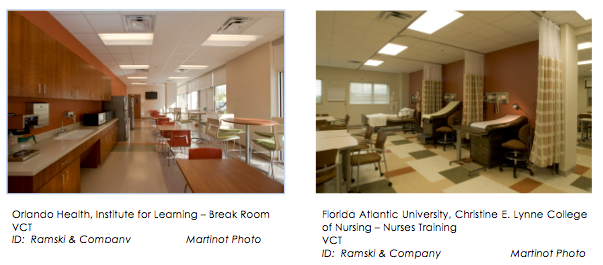
BioBased VCT
One “green” step away from traditional VCT is an alternative like Armstrong’s BioBased tile which has the same maintenance regimen but is made with rapidly renewable, U.S. grown plant materials and emits low VOC’s (volatile organic compounds) promoting good IAQ (indoor air quality). Also, a 12″ x 12″ tile, BioBased has a slightly less varied color palette with fewer color choices (approximately $2.00 sq. ft. installed).
Carpet Tile and Broadloom Carpet
Increasing in popularity for healthcare environments is carpet tile. In many non-critical care healthcare spaces, carpet tile offers many positives.
- There are beautiful suites of patterns and colors that can add comfort and/or interest to any space by simply delineating an installed pattern to change color or texture.
- Carpet tile is warm and quiet. It is a natural acoustical conditioner, promoting speech privacy in large spaces. Carpet tile may have a cushion back for added comfort.
- Capet tile is very easy to ship, store and install, and manufacturers have developed glue less, tack methods that are quick, trouble free and environmentally friendly. It is easily field cut for dramatic graphic installations.
- Carpets soft surface and stable backing reduces fall related injuries.
- Solution dying produces permanent color that resists fading with even stringent cleaning.
- A varied background in certain patterns makes one or two tile replacement unnoticeable. This reduces the cost of “fixes”. Replacement is quick, easy, and undetectable.
A fair cost range for performance carpet tile installed is approximately $30 – $35 sq. yd. or $2.50 – $3.00 sq. ft. The traditional broadloom carpet (12′-0″ wide rolled goods) is still a cost effective partner for offices and areas where replacement and heavy traffic is not such a big concern.
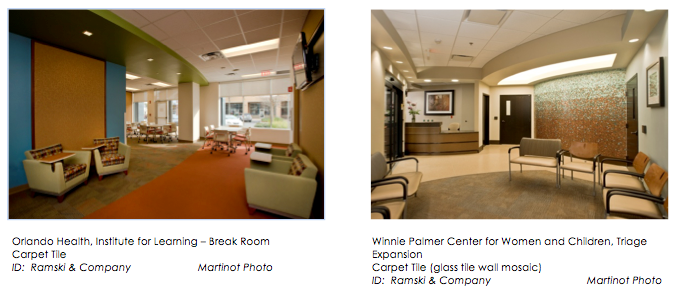
Luxury Vinyl Tiles (LVT) and Vinyl Planks
Also increasing in popularity for commercial healthcare environments is LVT. Innovation in printing techniques has produced marvelous fantasy finishes as well as remarkably realistic ones in the vinyl world. Along with 18″ x 18″ or 24″ x 24″ modular products, there are numerous “plank patterns” in “wood look” that come in varying sizes and “species” and some even have beveled edges to enhance the plank effect. The advantages to these products are high resiliency, high point loads to resist indentation, more sound absorption than VCT or porcelain tile, promotion of staff comfort and in a no wax line, an ease of maintenance and associated costs. Vinyl tiles easily pattern and can be waterjet cut prior to installation for more intricate patterns. They are often manufactured with antimicrobial additives.
Vinyl rolled goods – generally 6′-0″ wide, can be cushion backed for added staff and guest comfort and installed with heat welded seams to form a complete germ barrier.
LVT’s and rolled vinyls have a wide range in cost but typically you can budget $6 – $8 sq. ft. installed.
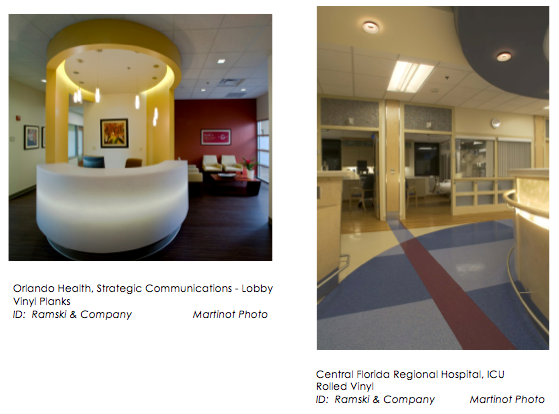
Linoleum
Linoleum today is not the material you remember in your grandmother’s kitchen. It is available in both tiles and rolled goods. It is very durable, flexible and sound absorptive. It is naturally antibacterial and antistatic. It gets stronger over time and its lifecycle is 30-40 years. It is easy to clean and does not require wax. It can be damp cleaned, but not wet cleaned. It can be waterjet cut to intricate patterns, and is made of rapidly renewable materials (approximate cost $5 sq. ft. installed, higher if intricately patterned).
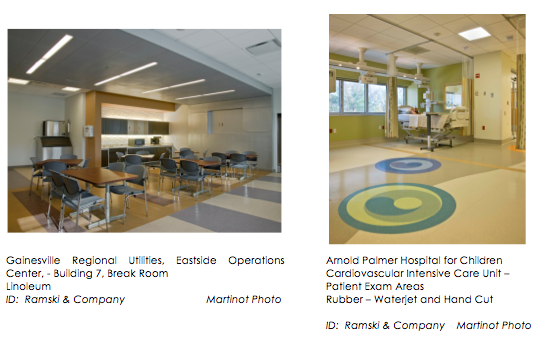
Rubber
Natural rubber tiles or rolled rubber flooring is a super performer in healthcare environments. Rubber is a rapidly renewable resource, very durable, a good shock and sound absorber, has a natural finish that gets better over time, is naturally antibacterial, is very low maintenance and comes in a beautiful array of color. This product is perfect for elderly and pediatric environments and is easily precut in intricate patterns with a waterjet technique.
Waterjet cutting has added a whole new world of design possibilities. Above is an example of the precision cuts possible on rolled, or tile installations. There is a price associated with this process, but it is softened by the ease with which the precut patterns are installed and the precision is far above that of field cutting. Rubber floors might average $6 – $8 sq. ft. installed. Intricacy of pattern will affect cost.
Porcelain Tile
Porcelain tile is also a wonderful material for healthcare projects. Like carpet, you may want to place it judiciously as it is incredibly durable and easy to clean with no liquid absorption, but very unforgiving to foot traffic and offers little sound buffer. Photography and “printing” techniques have become so sophisticated it is difficult to tell porcelain from many real stones and a huge variety of sizes, textures, and colors are available for creative installations. With the perfection of thinset (1/4″) installations, it is a very cost effective and attractive alternate to natural stone.
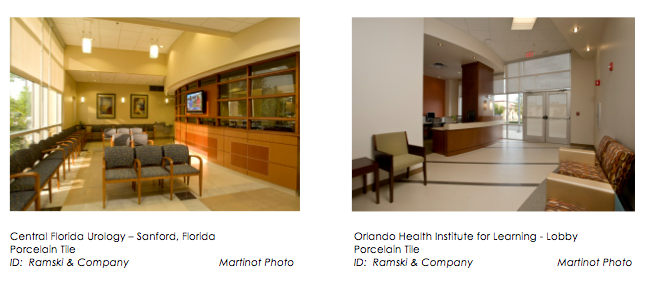
Porcelain and other forms of tile are popular for walls as well as for floors and recently very thin (1/4″) flexible large scale tiles are making their way from Europe to the U.S. Flexible tiles up to 5′ x 5′ for indoor and outdoor installations are showing up in the architectural landscape. Glass tile mosaic patterns or literal computerized graphics have become popular as environmental art. Natural stone look porcelains in 12″ x 12″ tiles can average $5.00 sq. ft. installed. More unique installations will be more costly and the introduction of epoxy grout for low absorption and high cleanability will increase costs.
This is a brief look at some of the many choices for flooring available to us in the healthcare market. Other options may include real wood flooring, engineered wood, laminate flooring, natural stone, terrazzo and terrazzo tiles among others. An interior design professional can assist you in making wise, current and cost effective choices for any healthcare environment based on installation knowledge, experience and constant education in an expanding world of product. Your design team will listen to your needs and help you select materials for optimum image, appearance retention, performance, budget and long term maintenance.
Your design team may involve product representatives, flooring dealerships, and installers. Healthcare is one of the most exciting sectors for design innovation and flooring is no exception, just one component of a successful healthcare environment design.
